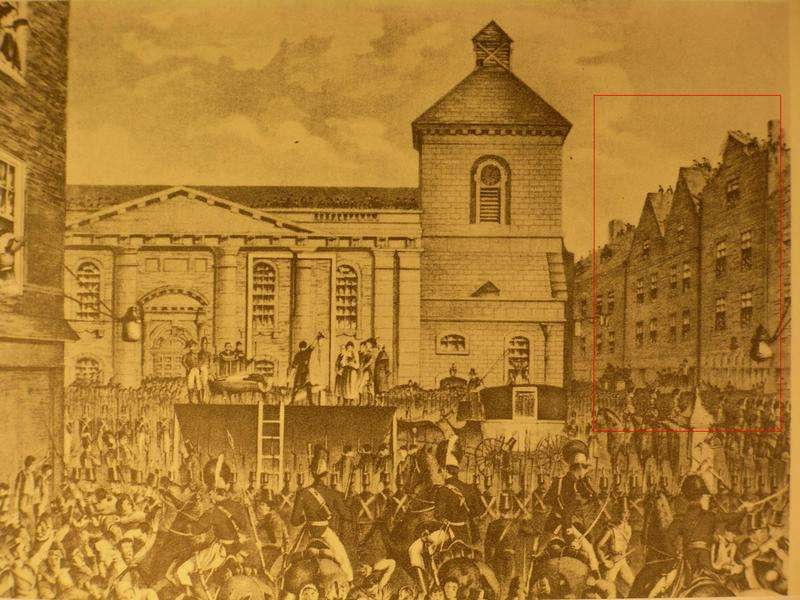
Drawing of a public execution on Thomas Street, Dublin
Drawing of a public execution on Thomas Street, Dublin. This picture is showing the historical gallows outside St. Catherine's church where Robert Emmet was executed in 1798.
Dublin ghost stories
She is Far from the LandShe is far from the land, where her young hero sleeps,
And lovers are round her, sighing;
But coldly she turns from their gaze, and weeps,
For her heart in his grave is lying!
She sings the wild song of her dear native plains,
Every note which he lov'd awaking
Ah! little they think, who delight in her strains,
How the heart of the Minstrel is breaking!
He had lov'd for his love, for his country he died,
They were all that to life had entwin'd him,
Nor soon shall the tears of his country be dried,
Nor long will his love stay behind him.
Oh! make her a grave, where the sun-beams rest,
When they promise a glorious morrow;
They'll shine o'er her sleep, like a smile from the West,
From her own lov'd Island of sorrow!
Thomas Moore www.robertemmet.orgThe Speech from the DockWhat have I to say why sentence of death should not be pronounced on me according to law? I have nothing to say that can alter your predetermination, nor that it will become me to say with any view to the mitigation of that sentence which you are here to pronounce, and I must abide by. But I have that to say which interests me more than life, and which you have labored (as was necessarily your office in the present circumstances of this oppressed country) to destroy. I have much to say why my reputation should be rescued from the load of false accusation and calumny which has been heaped upon it. I do not imagine that, seated where you are, your minds can be so free from impurity as to receive the least impression from what I am going to utter--I have no hopes that I can anchor my character in the breast of a court constituted and trammeled as this is--I only wish, and it is the utmost I expect, that your lordships may suffer it to float down your memories untainted by the foul breath of prejudice, until it finds some more hospitable harbor to shelter it from the storm by which it is at present buffeted.
Was I only to suffer death after being adjudged guilty by your tribunal, I should bow in silence and meet the fate that awaits me without a murmur; but the sentence of law which delivers my body to the executioner will, through the ministry of that law, labor in its own vindication to consign my character to obloquy--for there must be guilt somewhere: whether in the sentence of the court in the catastrophe, posterity must determine. A man in my situation, my lords, has not only to encounter the difficulties of fortune. and the force of power over minds which it has corrupted or subjugated. but the difficulties of established prejudice: the man dies, but his memory lives. That mine may not perish, that it may live in the respect of my countrymen, I seize upon this opportunity to vindicate myself from some of the charges alleged against me. When my spirit shall be wafted to a more friendly port; when my shade shall have joined the bands of those martyred heroes who have shed their blood on the scaffold and in the field, in defense of their country and of virtue. this is my hope: I wish that my memory and name may animate those who survive me, while I look down with complacency on the destruction of that perfidious government which upholds its domination by blasphemy of the Most High-which displays its power over man as over the beasts of the forest-which sets man upon his brother, and lifts his hand in the name of God against the throat of his fellow who believes or doubts a little more or a little less than the government standard--a government which is steeled to barbarity by the cries of the orphans and the tears of the widows which it has made...
My lords, you are impatient for the sacrifice-the blood which you seek is not congealed by the artificial terrors which surround your victim; it circulates warmly and unruffled, through the channels which God created for noble purposes. but which you are bent to destroy. for purposes so grievous. that they cry to heaven. Be yet patient! I have but a few words more to say. I am going to my cold and silent grave: my lamp of life is nearly e4inguished: my race is run: the grave opens to receive me, and I sink into its bosom! I have but one request to ask at my departure from this world--it is the charity of its silence! Let no man write my epitaph: for as no man who knows my motives dare now vindicate them. let not prejudice or ignorance asperse them. Let them and me repose in obscurity and peace, and my tomb remain uninscribed, until other times, and other men, can do justice to my character; when my country takes her place among the nations of the earth, then, and not till then, let my epitaph be written. I have done.






-visible-state7.gif)
